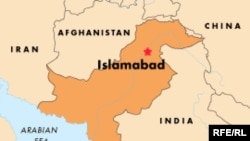A recent story in "The New York Times" making waves in the blogosphere begins with a description of how a hypothetical map of South Asia and the Middle East -- showing new states and current states being either enlarged or cut smaller -- is doing the rounds in Pakistani elite circles.
The map is apparently fuelling conspiracy theories that the real U.S. objective in the region is the breakup of Pakistan, the only nuclear-armed Muslim country.
With the recent increase in U.S. drone and missile attacks inside Pakistan, the media was all over the story. A leading anchor showed the map at the beginning of a talk show with leading legislators discussing the drone attacks. Two of the three participants went to great lengths to prove that a complicated conspiracy was under way to destabilize Pakistan.
The map -- which was originally published alongside an article in the "Armed Forces Journal" in 2006 -- was not taken seriously in Western academic and policymaking circles.
Experts maintain that the problem with redrawing maps is that one never knows when and where to stop, and in the end such realignments (if at all possible) might only serve to create new problems. Also, the world today is very different from the 19th century and the first half of the 20th century, when Western cartographers had the luxury of drawing lines on maps -- mostly how they pleased.
That said, the central premise in the article that the Pakistani elite is paranoid about its security situation is very true and important in understanding modern-day Pakistan.
It helps us to understand the dilemmas Pakistan's establishment faces and what compels it to adopt policies that make little sense to its domestic and foreign critics. For example, some in the West are startled to hear that some in Pakistani officialdom don't see Islamic radicals as the major threat to global -- or rather, Western -- security.
Rather, for many Pakistanis, the disputed Himalayan region of Kashmir, perceived Indian influence in Afghanistan, and worries about long-term Western strategic objectives -- with the numbers of their troops increasing in the region -- are more significant worries.
A recent "Foreign Affairs" article by Barnett Rubin and Ahmed Rashid manages to untangle such complexities.
The solution they recommend -- a regional settlement attempting to resolve a series of complicated conflicts in and around Afghanistan -- is the best course available to policymakers, in both the East and the West.
The authors' point is that redrawing maps won't matter as long as the circumstances for locals are not changed and all local players have a sense of gaining something from a comprehensive regional settlement. As Rubin and Rashid aptly summarize:
"The crisis in Afghanistan and Pakistan is beyond the point where more troops will help. U.S. strategy must be to seek compromise with insurgents while addressing regional rivalries and insecurities."
-- Abubakar Siddique
The map is apparently fuelling conspiracy theories that the real U.S. objective in the region is the breakup of Pakistan, the only nuclear-armed Muslim country.
With the recent increase in U.S. drone and missile attacks inside Pakistan, the media was all over the story. A leading anchor showed the map at the beginning of a talk show with leading legislators discussing the drone attacks. Two of the three participants went to great lengths to prove that a complicated conspiracy was under way to destabilize Pakistan.
The map -- which was originally published alongside an article in the "Armed Forces Journal" in 2006 -- was not taken seriously in Western academic and policymaking circles.
Experts maintain that the problem with redrawing maps is that one never knows when and where to stop, and in the end such realignments (if at all possible) might only serve to create new problems. Also, the world today is very different from the 19th century and the first half of the 20th century, when Western cartographers had the luxury of drawing lines on maps -- mostly how they pleased.
That said, the central premise in the article that the Pakistani elite is paranoid about its security situation is very true and important in understanding modern-day Pakistan.
It helps us to understand the dilemmas Pakistan's establishment faces and what compels it to adopt policies that make little sense to its domestic and foreign critics. For example, some in the West are startled to hear that some in Pakistani officialdom don't see Islamic radicals as the major threat to global -- or rather, Western -- security.
Rather, for many Pakistanis, the disputed Himalayan region of Kashmir, perceived Indian influence in Afghanistan, and worries about long-term Western strategic objectives -- with the numbers of their troops increasing in the region -- are more significant worries.
A recent "Foreign Affairs" article by Barnett Rubin and Ahmed Rashid manages to untangle such complexities.
The solution they recommend -- a regional settlement attempting to resolve a series of complicated conflicts in and around Afghanistan -- is the best course available to policymakers, in both the East and the West.
The authors' point is that redrawing maps won't matter as long as the circumstances for locals are not changed and all local players have a sense of gaining something from a comprehensive regional settlement. As Rubin and Rashid aptly summarize:
"The crisis in Afghanistan and Pakistan is beyond the point where more troops will help. U.S. strategy must be to seek compromise with insurgents while addressing regional rivalries and insecurities."
-- Abubakar Siddique




